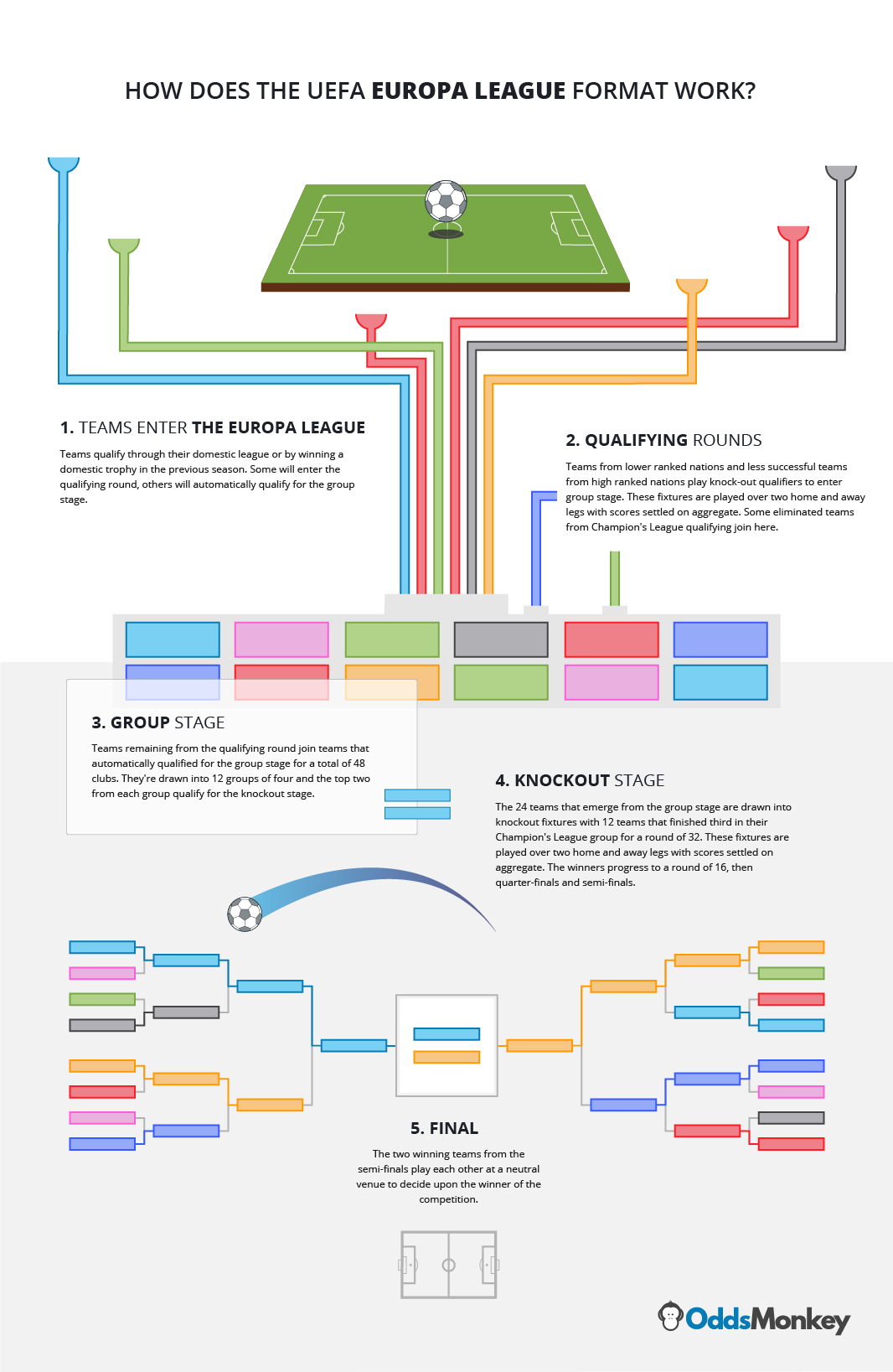During the European football season, many of the continent’s biggest clubs take part in the UEFA Europa League. Though less prestigious in comparison to its sister competition the Champion’s League, the Europa League is still very competitive and attracts many quality teams with squads full of world-class players. And, when the cup reaches its final stages, there are usually some great matches and a lot of drama for football fans to look forward to.
In this guide, we are going to take a look at all the essential details of the UEFA Europa League so that you’re ready to enjoy the 2019 edition. We also have a guide to the Europa League final that’s worth a look before that last fixture comes around.
- What is the UEFA Europa League?
- When to start betting on the Europa League
- What bets should I place
- UEFA League round guide
What is the UEFA Europa League?
The UEFA Europa League (UEL) is a football competition that takes place every year through the European season (August to May). Clubs enter from all over the continent, qualifying based on their domestic league and cup performance, then begin to play each other through qualification rounds, a group stage and, finally, knockout fixtures until a champion is crowned.
The cup is organised by UEFA — the football governing body of Europe — as their tier two competition, ranking below the Champion’s League (UCL) in terms of prestige. It has been running since 1971, though it was known for most of its lifespan known as the UEFA Cup before a 2009 rebrand. It has also grown to absorb the discontinued Cup Winner’s Cup and Intertoto Cup.
How does the UEFA Europa League format work?

Do away goals count in the Europa League?
Yes, the Europa League uses the “away goals rule” as a tie-break method in the qualifiers and knockout phase where two-legged home and away fixtures take place. The rule is not used in group games, where a draw is acceptable, or the final, where there is just one match.
The rule sees goals scored by a team in the away leg count as double if the aggregate score — the goals from both games added together — is tied. This means that the team that has scored the most away goals will win the tie and progress in the competition. UEFA applies the rule after normal time, but if the scores are still tied, 30 minutes of extra time is played. If there are no away goals scored in extra time and scores remain level, a penalty shootout takes place.
Are there any rewards for winning the UEFA Europa League?
Apart from enjoying the prestige of winning one of Europe’s premier competitions, there are a few added benefits to winning the UEFA Europa League.
Firstly, the winner automatically secures a spot in the next season’s Champion’s League group stage, so it can be a great prize if a team usually doesn’t qualify for that competition or is having a poor domestic season. Secondly, the winner gets to challenge for more silverware in the UEFA Super Cup, the organisation’s showpiece final that sees the winner of the Europa League play the winner of the Champion’s League at the beginning of the next season.
There is also a financial benefit for clubs competing, with different amounts of prize money awarded for reaching certain stages. The UEFA Europa League prize money is as follows:
- Reaching the preliminary round: €220,000
- Reaching the first qualifying round: €240,000
- Reaching the second qualifying round: €260,000
- Reaching the third qualifying round: €280,000
- Being eliminated at the play-off stage: €300,000
- Base fee for group stage participation: €2,920,000
- Prize for a group match victory: €570,000
- Prize for a group match draw: €190,000
- Winning the group: €1,000,000
- Finishing second in the group: €500,000
- Reaching the round of 32: €500,000
- Reaching the round of 16: €1,100,000
- Reaching the quarter-finals: €1,500,000
- Reaching the semi-finals: €2,400,000
- Losing finalist: €4,500,000
- Winners: €8,500,000
When to start betting on the UEFA Europa League
Usually, you can start your Europa League betting as soon as the teams competing are confirmed at the end of the season in May. The tournament lasts for the whole football season, from the initial qualifying rounds in the summer to the final the following May, so it provides a good source for placing your bets through most of the year.
Many people like to place bets on individual matches on a regular basis, as well as choosing an outright winner of the competition. You may also wish to bet on the outcome of the group stages or whether a team will reach a particular round. It’s worth noting that if you’re looking to place a bet on a certain team you think will win the cup, the earlier you place the bet, the better Europa League odds you’re likely to get.
It’s also worth remembering that teams eliminated from the Champion’s League also enter the cup at certain stages, and that these are likely to be quality sides that could be among the favourites to win. And, because nobody knows who these teams are likely to be until the group stage is over, a big team entering at the knockout stage — like Napoli, Valencia, or Internazionale this year — could mean that the current favourite has more competition, which could see the odds shift dramatically.
If you’re an OddsMonkey member, you should check out our Europa League threads on our matched betting forum, where the latest and best offers will be listed.
What bets should I place? Are there any UEFA Europa League betting tips?
Now that you’re familiar with the format and know when you can start your UEFA Europa League betting, you’re probably wondering if there are any tips for placing the right bet. Here are a few things to consider if you’re looking to put your money in the smart places:
- Listen to the experts: Everyone has an opinion on the big match, but football pundits are well placed to make predictions about what the result will be. Most will have in-depth knowledge of the game and access to the latest statistics, so their opinions are usually worth listening to. That being said, even the most reliable pundit will struggle to predict upsets, which happen regularly in football.
- Look at what odds are available: Like pundits, bookmakers aren’t always right, but you can be confident that they’ve looked at a wide range of factors before deciding who is the hot favourite for the match. The odds may also influence who you bet on: if you’re looking to place a riskier bet for higher returns, then find a team that isn’t the favourite, but you could definitely see causing an upset. Conversely, if you want to place a safe bet, then picking a team that is backed by short odds is a better choice.
- Look at a team’s recent form: A team’s recent form is probably the best indicator of how well they’re likely to play in an upcoming game, so be sure to check out their recent results. After all, if they’re in bad form, confidence is probably low and they might be feeling under pressure, whereas a side that’s on a roll is better placed to put in a good performance. But upsets do happen, so recent form shouldn’t be the only thing you take into account.
- Look at a team’s history in the Europa League: It’s also worth looking at a team’s history in the competition to see if they regularly do well or struggle to get past a certain round each season. For instance, some clubs might have a squad of players with big game experience that can handle a semi-final better than an experienced team. Or, a certain club might consistently reach the group stage but always fail to reach the knockout round.
- Keep up to date with team news: In football, suspensions, injuries, and a manager’s team selection can be the difference between a win, loss, or a draw. Keep your ear to the ground for team news as the match gets closer as you might pick up some key information. The hot favourite’s star player might pick up an injury, a key defender could be suspended, or the manager may even have had a falling out with an important squad member. All of these can be enough to tip the balance of a match.
- Research previous meetings between the teams: Unlike domestic leagues, where the same sides will play each other at least a couple of times each season, previous meetings are a lot rarer across a continental competition like the Europa League. However, it is still worth checking to see if the two clubs have played each other recently and seeing what the outcome was. Also, be sure to keep an eye out for teams from the same nation playing one another, as there will be a lot of past results to look back on.
- Know where to look for the best insight: When it comes to doing research before placing your bets, there are a few places that are worth checking out. WhoScored? and SoccerSTATS are two great websites for looking at in-depth statistics about team and player performance, so be sure to have a dig around there for information. You should also keep an eye on the football press to get expert’s opinions and the latest team news.
Looking to bring in some extra cash from your betting on a regular basis? Then it’s worth looking into matched betting, which offers a low-risk method for adding to your income.
As an OddsMonkey member, you can access the latest Europa League betting offers in our matched betting forum, as well as being able to access tools like our Oddsmatcher, Each Way Matcher, and Acca Matcher to assist you in making a profit. Even if you have little knowledge of the Europa League or the teams involved, our matched betting service makes it easy to make money from your bets.
UEFA Europa League 2018/19 round guide
If you’re looking to place bets on the UEFA Europa League throughout the 2018/19 season, then it can help to familiarise yourself with the round schedule to know when the next games are. Below, we’ve created a guide to each round, including dates and details on progression.
The table below shows the distribution of teams for the Europa League format. This year, a new “champion’s path” was created in the qualifying rounds for domestic champions eliminated from the UCL, ensuring that these champions compete against one another for a place in the group stage.
Also, where there is a reference to “association xx” this refers to UEFA’s country coefficients, which rank football associations’ success and are used to determine when teams from that country enter the Europa League. Generally, the higher the ranking, the later the teams enter the tournament.
| Teams entering this round | Teams advancing from previous round | ||
| Preliminary round (16 teams) | ü 6 domestic cup winners from associations 50–55
ü 6 domestic league runners-up from associations 49-54 ü 4 domestic league third-placed teams from associations 48–51 |
||
| First qualifying round (94 teams) | ü 25 domestic cup winners from associations 25–49
ü 30 domestic league runners-up from associations 18–48 (not Liechtenstein) ü 31 domestic league third-placed teams from associations 16–47 (not Liechtenstein) |
ü 8 winners from preliminary round
|
|
| Second qualifying round | Champion’s path (20 teams) | ü 17 losers from UCL first qualifying round
ü 3 losers from UCL preliminary round |
|
| Main path (74 teams) | ü 7 domestic cup winners from associations 18–24
ü 2 domestic league runners-up from associations 16–17 ü 3 domestic league third-placed teams from associations 13–15 ü 9 domestic league fourth-placed teams from associations 7–15 ü 2 domestic league fifth-placed teams from associations 5–6 ü 4 domestic league sixth-placed teams from associations 1–4 |
ü 47 winners from first qualifying round | |
| Third qualifying round | Champion’s path (20 teams) | ü 10 losers from UCL second qualifying champion’s path | ü 10 winners from second qualifying champion’s path |
| Main path (52 teams) | ü 5 domestic cup winners from associations 13–17
ü 6 domestic league third-placed teams from associations 7–12 ü 1 domestic league fourth-place team from association 6 ü 3 losers from UCL second qualifying round main path |
ü 37 winners from second qualifying round main path | |
| Play-offs | Champion’s path (16 teams) | ü 6 losers from UCL third qualifying round champion’s path | ü 10 winners from third qualifying round champion’s path |
| Main path (26 teams) | ü 26 winners from third qualifying round main path | ||
| Group stage (48 teams) | ü 12 domestic cup winners from associations 1–12
ü 1 domestic league fourth-place team from association 5 ü 4 domestic league fifth-place teams from associations 1–4 ü 6 losers from UCL play-off round ü 4 losers from UCL third qualifying round for non-champions |
ü 21 winners from play-off round | |
| Knockout stage (32 teams) | ü 12 group winners from group stage
ü 12 group runners-up from group stage ü 8 third-placed teams from UCL group stage |
||
| Final (2 teams) | ü 2 winners from knockout semi-finals | ||
Preliminary round
Number of teams: 16
Number of ties: 8
When is the Europa League preliminary round draw? Early June
When do the fixtures take place? Late June/early July
How it works: There are eight two-legged fixtures played between cup winners, runners up, and third-placed teams from the lower ranked associations. The winners move onto the first qualifying round and the losers are eliminated from the competition.
First qualifying round
Number of teams: 94
Number of ties: 47
When is the Europa League first qualifying round draw? Mid-June
When do the fixtures take place? Mid-July
How it works: There are 47 two-legged fixtures played between cup winners, league runners up, and league third-placed teams from a mix of lower and mid-ranked associations, as well as the winners from the preliminary round. The winners move onto the second qualifying round and the losers are eliminated from the tournament.
Second qualifying round
When is the Europa League second qualifying round draw? Mid-June
When do the fixtures take place? Late July/Early August
When qualification reaches this point, it splits into two separate paths: the champion’s path for eliminated UCL domestic champions and the main path for everyone else.
Champion’s path
Number of teams: 20
Number of ties: 10
How it works: There are usually 10 two-legged fixtures played between domestic champions eliminated from UCL first qualifying round and UCL preliminary round. The winners move onto the third qualifying round champion’s path and the losers are eliminated from the tournament.
Main path
Number of teams: 74
Number of ties: 37
How it works: There are 37 two-legged fixtures played between cup winners, league runners up, third-, fourth-, fifth-, and sixth-place teams from a mix of low-, mid-, and high-ranked associations, as well as the winners from the first qualifying round. The winners move onto the third qualifying round main path and the losers are eliminated from the tournament.
Third qualifying round
When is the Europa League third qualifying round draw? Mid-July
When do the fixtures take place? Early August
Champion’s path
Number of teams: 20
Number of ties: 10
How it works: There are 10 two-legged fixtures played between domestic champions eliminated from UCL second qualifying round and the winners from the UEL second qualifying round champion’s path. The winners move onto the champion’s path play-offs and the losers are eliminated from the tournament.
Main path
Number of teams: 52
Number of ties: 26
How it works: There are 26 two-legged fixtures played between cup winners, third- and fourth-place teams from mid- and high-ranked associations, as well as some teams eliminated from the UCL second qualifying round main path. There are also the 37 teams who progressed from the UEL second qualifying round main path. The winners move onto the main path play-offs and the losers are eliminated from the tournament.
Play-off round
When is the Europa League play-off round draw? Early-August
When do the fixtures take place? Mid/late August
Champion’s path
Number of teams: 16
Number of ties: 8
How it works: There are 8 two-legged fixtures played between domestic champions eliminated from UCL third qualifying round and the winners from the UEL third qualifying round champion’s path. The winners qualify for the group stage and the losers are eliminated from the tournament.
Main path
Number of teams: 26
Number of ties: 13
How it works: There are 13 two-legged fixtures played between the winners of the third qualifying round main path. The winners qualify for the group stage and the losers are eliminated from the tournament.
Group stage
Number of teams: 48 (12 groups of 4)
Number of ties: 24 matches per group (288 in total)
When is the Europa League group stage draw? Late August
When do the fixtures take place? September–December
How it works: There are 12 groups (A–L) of four teams drawn from a pool containing the winners of the main and champion’s path play-offs, as well as cup winners, fourth-, and fifth-place teams from higher ranked associations who automatically qualify for the group. They are also joined by teams eliminated from the UCL third-round main path and play-offs.
Teams play each other twice — home and away — with the top two in the group qualifying for the knockout phase. Teams tied on points are ranked by goal difference (goals for less goals against).
Knockout stage
Number of teams: 32
Number of ties:
- Round of 32 – 16
- Round of 16 – 8
- Quarter finals – 4
- Semi-finals – 2
When is the Europa League knockout stage draw?
- Round of 32 – Mid-December
- Round of 16 – Mid-February
- Quarter finals – Mid-March
- Semi-finals – Mid-March
When do the fixtures take place?
- Round of 32 – Mid-February
- Round of 16 – Early March
- Quarter finals – Mid-April
- Semi-finals – Early May
How it works: The 24 teams that qualified from the group stage are joined by 8 teams that finished third in the UCL group stage for a round of 32, with knockout fixtures played over home and away legs. A round of 16 is drawn from the winners of the previous round and played over two legs.
When the competition reaches the final eight teams, a draw takes place to determine both the quarter final and semi-final fixtures. From this point, a team can see who they may have to play before reaching the final. Ties are again played over two home and away legs.
Final
Number of teams: 2
Number of ties: 1
When is the Europa League final? May
How it works: After the semi-finals, there are two remaining teams who play each other in the final. It takes place in a neutral venue over one match. Extra time and penalties are used if the teams are drawing at the end of normal time. Take a look at our UEFA Europa League final 2019 guide for a more in-depth look at the final and handy betting advice.
We hope you found the advice and information in this guide useful. Hopefully you’ll know the ins and outs of the UEFA Europa League, as well as how best to place your bets on the competition.
Remember, the best way to earn cash from Europa League betting is through matched betting, a method that we here at OddsMonkey make very easy. Simply become a member to access a bunch of great features and support.





